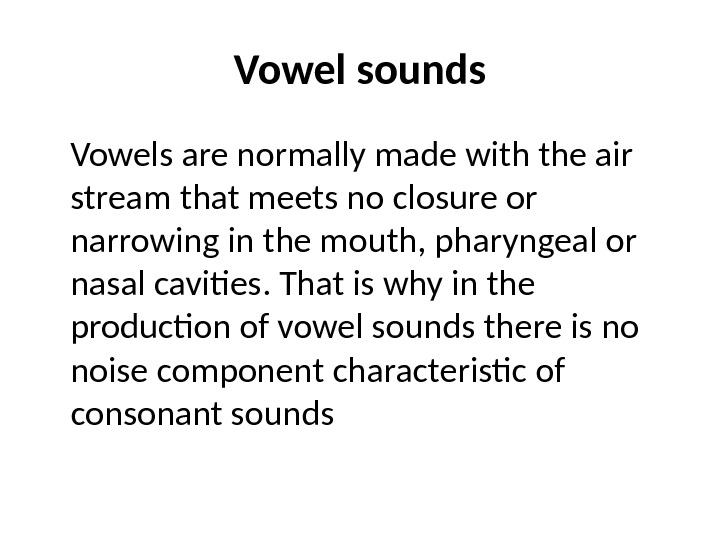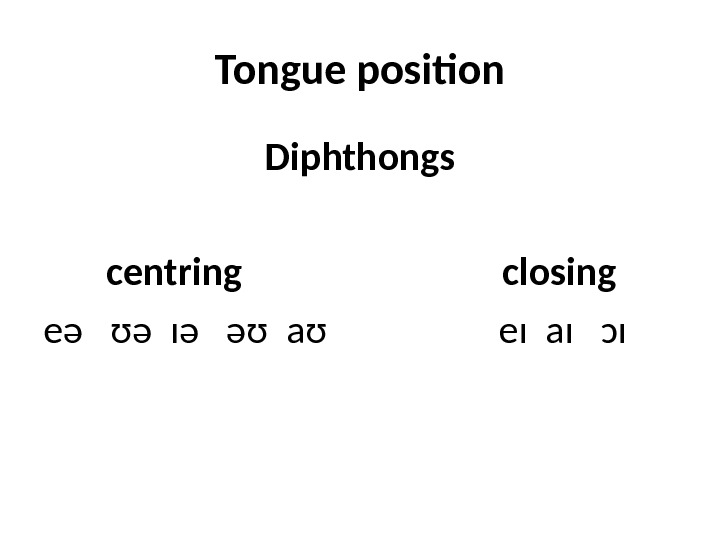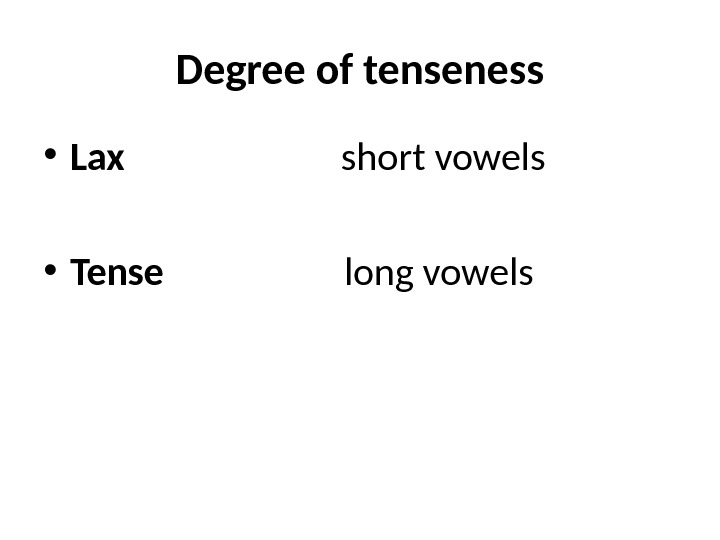Презентация classification of sounds
































- Размер: 143 Кб
- Количество слайдов: 31
Описание презентации Презентация classification of sounds по слайдам
 C_ _ld y_ _ p_ss m_ _ p_ _c_ _f str_ng, pl_ _s_. _ou_ _ _ou _a_ _ _e a _ie_e o_ _ _ _i_ _, _ _ea_e.
C_ _ld y_ _ p_ss m_ _ p_ _c_ _f str_ng, pl_ _s_. _ou_ _ _ou _a_ _ _e a _ie_e o_ _ _ _i_ _, _ _ea_e.
 Consonant sounds Consonants are made with air stream that meets an obstruction in the mouth or nasal cavities. That is why in the production of consonant sounds there is a certain degree of noise
Consonant sounds Consonants are made with air stream that meets an obstruction in the mouth or nasal cavities. That is why in the production of consonant sounds there is a certain degree of noise
 On the articulatory level the consonants change: 1. In the degree of noise 2. In the manner of articulation 3. In the place of articulation
On the articulatory level the consonants change: 1. In the degree of noise 2. In the manner of articulation 3. In the place of articulation
 The degree of noise • Noise consonants • Sonorants
The degree of noise • Noise consonants • Sonorants
 Noise consonants • Voiced • Weak (lenis) b d ɡ v z ð ʒ ʤ • Voiceless • Strong (fortis) p t k f s θ ʧ ʃ h
Noise consonants • Voiced • Weak (lenis) b d ɡ v z ð ʒ ʤ • Voiceless • Strong (fortis) p t k f s θ ʧ ʃ h
 sonorants m n ŋ w l r j
sonorants m n ŋ w l r j
 The manner of articulation • Occlusive • Constrictive • Occlusive-constrictive (affricates) • Rolled
The manner of articulation • Occlusive • Constrictive • Occlusive-constrictive (affricates) • Rolled
 Occlusive noise consonants • Voiced • Weak b d ɡ • Voiceless • Strong p t k
Occlusive noise consonants • Voiced • Weak b d ɡ • Voiceless • Strong p t k
 Occlusive sonorants m n ŋ
Occlusive sonorants m n ŋ
 Constrictive noise consonants (fricatives) • Voiced • Weak v z ð ʒ • Voiceless • Strong f s θ ʃ h
Constrictive noise consonants (fricatives) • Voiced • Weak v z ð ʒ • Voiceless • Strong f s θ ʃ h
 Constrictive sonorants w r l j
Constrictive sonorants w r l j
 Affricates • Voiced • Weak ʤ • Voiceless • Strong ʧ
Affricates • Voiced • Weak ʤ • Voiceless • Strong ʧ
 The place of articulation unicentral bicentral
The place of articulation unicentral bicentral
 The place of articulation • Labial • Lingual • Glottal
The place of articulation • Labial • Lingual • Glottal
 Labial consonants • Bilabial p b m w • Labio-dental f v
Labial consonants • Bilabial p b m w • Labio-dental f v
 Lingual consonants • Forelingual • Mediolingual • Backlingual
Lingual consonants • Forelingual • Mediolingual • Backlingual
 Forelingual consonants • Apical t d s z f ʒ θ ð ʤ ʧ n l • Dorsal • Cacuminal r
Forelingual consonants • Apical t d s z f ʒ θ ð ʤ ʧ n l • Dorsal • Cacuminal r
 Forelingual consonants • Interdental θ ð • Dental • Alveolar t d s z n l • Post-alveolar r • Palato-alveolar ʧ ʤ ʒ ʃ
Forelingual consonants • Interdental θ ð • Dental • Alveolar t d s z n l • Post-alveolar r • Palato-alveolar ʧ ʤ ʒ ʃ
 Mediolingual consonant j Backlingual consonants k ɡ ŋ
Mediolingual consonant j Backlingual consonants k ɡ ŋ
 Glottal consonant h
Glottal consonant h
 Vowel sounds Vowels are normally made with the air stream that meets no closure or narrowing in the mouth, pharyngeal or nasal cavities. That is why in the production of vowel sounds there is no noise component characteristic of consonant sounds
Vowel sounds Vowels are normally made with the air stream that meets no closure or narrowing in the mouth, pharyngeal or nasal cavities. That is why in the production of vowel sounds there is no noise component characteristic of consonant sounds
 On the articulatory level vowels are classified according to • The stability of articulation • The tongue position • The lip position • The character of the vowel end • The degree of tenseness • Length
On the articulatory level vowels are classified according to • The stability of articulation • The tongue position • The lip position • The character of the vowel end • The degree of tenseness • Length
 Stability of articulation • Monophthongs • Diphthongs eɪ aɪ ɔɪ eə ʊə ɪə əʊ aʊ • Diphthongoids i: u:
Stability of articulation • Monophthongs • Diphthongs eɪ aɪ ɔɪ eə ʊə ɪə əʊ aʊ • Diphthongoids i: u:
 Tongue position • Fully front i: e æ • Front retracted ɪ • Central ɜ : Ə ʌ • Fully back ɒ ɔ: u: • Back advanced ʊ ɑ:
Tongue position • Fully front i: e æ • Front retracted ɪ • Central ɜ : Ə ʌ • Fully back ɒ ɔ: u: • Back advanced ʊ ɑ:
 Tongue position • close (high) i: ɪ ʊ u: • mid e ɜ: ə • open (low) ʌ æ ɒ ɑ:
Tongue position • close (high) i: ɪ ʊ u: • mid e ɜ: ə • open (low) ʌ æ ɒ ɑ:
 Tongue position Diphthongs centring closing eə ʊə ɪə əʊ aʊ eɪ aɪ ɔɪ
Tongue position Diphthongs centring closing eə ʊə ɪə əʊ aʊ eɪ aɪ ɔɪ
 Lip position • rounded ɒ ɔ: ʊ u: • unrounded
Lip position • rounded ɒ ɔ: ʊ u: • unrounded
 Degree of tenseness • Lax short vowels • Tense long vowels
Degree of tenseness • Lax short vowels • Tense long vowels
 Character of the vowel end • Checked vowel + weak voiceless consonant cart • Unchecked/free vowel + strong voiced consonant vowel + Ø head
Character of the vowel end • Checked vowel + weak voiceless consonant cart • Unchecked/free vowel + strong voiced consonant vowel + Ø head
 Length Short Long
Length Short Long
 Length Linguistic factors • Position of the vowel in a word tie — tied – tight • Word stress forecast [‘fɔ: kɑst] to forecast [fɔ’kɑ: st] • The number of syllables in a word verse [ɜ: ] is longer than in university
Length Linguistic factors • Position of the vowel in a word tie — tied – tight • Word stress forecast [‘fɔ: kɑst] to forecast [fɔ’kɑ: st] • The number of syllables in a word verse [ɜ: ] is longer than in university

